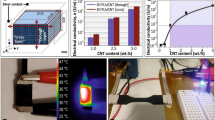Abstract
A κ-carrageenan–Pt nanoparticle composite (Cg–Pt) was synthesized and its proton conductivity was examined by a complex-plane impedance method. The synthesized Cg–Pt was characterized by transmission electron microscope (TEM) observation, powder X-ray diffraction (XRD), Fourier transformed infrared (FT-IR) absorption measurements, and thermogravimetry/mass spectrometry (TG/MS) analysis. It was revealed that the a.c. electrical conductivity of Cg–Pt strongly depends on relative humidity (RH) and exceeds the conductivity of Cg under conditions of high humidity. From the temperature dependence of the a.c. conductivity, activation energies for protonic conduction were estimated to be 0.47 and 0.34 eV for Cg–Pt and Cg, respectively. The origin of the differences in the conductivities and activation energies are discussed.






Similar content being viewed by others
References
Akiba E (2005) Advanced technologies and materials for hydrogen energy. CMC Publishing, Tokyo
Yamauchi M, Kitagawa H (2005) Synth Met 153:353
Yamauchi M, Kitagawa H (2005) Chem Eng Trans 8:159
Lu P, Teranishi T, Asakura K, Miyake M, Toshima N (1999) J Phys Chem B 103:9673
Ohtaki M, Toshima N, Komiyama M, Hirai H (1990) Bull Chem Soc Jpn 63:1433
Brugger P-A, Cuendet P, Grätzel M (1981) J Am Chem Soc 103:2923
Toshima N, Nakata K, Kitoh H (1997) Inorg Chim Acta 265:149
Roeder J, Silva H, Nunes SP, Pires ATN (2005) Solid State Ionics 176:1411
Mikrajuddin FG, Shi K, Okuyama J (2000) Electrochem Soc 147:3157
Steinbüchel A, Marchessault RH (2005) Biopolymers for medical and pharmaceutical applications. Wiley-VCH, Weinheim
Scherrer P (1918) Nachr Gött 2:98
Colomban P (1992) Proton conductors solids, membranes and gels—materials and devices. Cambridge University Press, New York
Maier J (1995) Prog Solid State Chem 23:171
Teranishi T, Hosoe M, Tanaka T, Miyake M (1999) J Phys Chem B 103:3818
Croce F, Appetecchi GB, Persi L, Scrosati B (1998) Nature 394:456
Acknowledgements
This work was partly supported by a Grant-in-Aid for Scientific Research (No. 17750060) and Nanotechnology Network Project (Kyushu-area Nanotechnology Network) from the Ministry of Education, Culture, Sports, Science and Technology (MEXT), and by the Japan Securities Scholarship Foundation, CASIO Science Promotion Foundation, Kansai Research Foundation for technology promotion, and Nippon Sheet Glass Foundation for Materials Science and Engineering.
Author information
Authors and Affiliations
Corresponding author
Rights and permissions
About this article
Cite this article
Fujishima, M., Takatori, H., Yamai, K. et al. Proton conductivity of biopolymer–platinum nanoparticle composite under high humidity. J Mater Sci 43, 3130–3134 (2008). https://doi.org/10.1007/s10853-008-2509-1
Received:
Accepted:
Published:
Issue Date:
DOI: https://doi.org/10.1007/s10853-008-2509-1




